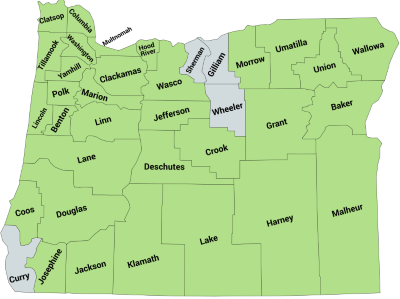Intensive In-Home Behavioral Health Treatment (IIBHT)
The DAETA Team collects data from community IIBHT programs to monitor program outcomes and inform service delivery. The team also partners with OHA to provide training and technical assistance to providers. You can read more about our team's work in the IIBHT 2022 Annual Report and IIBHT 2023 Annual Report.
Contact: IIBHTinfo@ohsu.edu
Funder: Oregon Health Authority
IIBHT is a Medicaid level of care for youth ages 0-20 with intensive behavioral health needs. The program offers a variety of in-home and community-based services, including: case management, psychiatric services, skills training, individual and family therapy, crisis support, and peer support.
Coordinated Care Organizations (CCOs) contract with community mental health agencies to provide IIBHT to their members. As of the end of 2024, there are 23 programs representing 32 counties and 16 CCOs serving youth. The map displays the counties in which IIBHT is currently available in green. Visit OHA's website for an up-to-date list of certified IIBHT providers.

A child must be enrolled in OHP, age 0-20, and have intensive behavioral health needs to be eligible for IIBHT. The youth must also have at least 2 behavioral health diagnoses, be impacted on multiple life domains, and be a significant safety risk or are at risk of (or are in transition home from) out-of-home treatment or placement.
Please contact your CCO or local program to learn about their referral and enrollment process.
For questions or comments specific to your IIBHT program or CCO, contact the CCO or provider directly.
For general questions or concerns, contact Beth Holliman, the Intensive Community-Based Services Coordinator at the Oregon Health Authority.
Visit the Oregon Health Authority's website to learn more about the program.
Trainings for Providers
In collaboration with OHA, the DAETA Team has developed a series of trainings to ensure standardization in service delivery across the state. Trainings include:
- IIBHT Foundations
- IIBHT Data Collection + REDCap
- IIBHT Clinical Services + Skills Training
- IIBHT Peer Delivered Services
Although it is not required, we recommend taking the IIBHT Foundations training before the other trainings since it is meant to be an introductory training to IIBHT. If you are an IIBHT provider and would like to register for a training, please visit our eventbrite page.
Data Collection Guidance for Providers
Please attend a REDCap training to learn about what data is required and how to submit that data to the OHSU DAETA Team. IIBHT REDCap Trainings are only available on an as-needed basis, so please reach out to us at IIBHTinfo@ohsu.edu to schedule a REDCap training. After attending the training, refer to the FAQs below for more information and reach out with any additional questions.
The fillable PDF forms will be sent to you upon completion of the IIBHT REDCap training. You can enroll for a training here.
A QMHP or QMHA completes the Enrollment Form, Closure Form, and the Ohio: Clinician. The parent, guardian, or casworker completes the Ohio: Parent form. The youth completes the Ohio: Youth, Hope Scale, and DSM-5 Level 1 and Level 2 Screening Form(s).
Versions of the Ohio Scales in alternate languages can be found here. The Hope Scale: Spanish Version is not available online; please email IIBHTinfo@ohsu.edu for a copy.
Please use your best clinical judgment/discretion when administering the forms outside of the age range. We will accept any forms that are uploaded, even if they are outside of the age range (we can always exclude them from future analyses).
The Ohio Scales Manual provides instructions for filling out these questions. An example of a question that may not be appropriate for younger youth would be item 3: “Dating or developing relationships with boyfriends or girlfriends.” This is what the Ohio Manual says to do in these instances: “A common question about the functioning scale involves the rating of items 3 and 13. For young children, raters often wonder how to rate items concerning vocational preparation (Item 13) or developing relationships with boyfriends or girlfriends (Item 3). On these items the rater should rate "OK (3)" if they are unsure or rate the youth based on what might be expected for their developmental level. For example, developmentally appropriate vocational preparation for a 7 year old typically involves school work, chores at home, and other work-like assignments. Note: If insufficient information is available to answer a specific item on the functioning scale, that item should be rated "OK (3)".”
We recommend downloading the forms and opening them using the Adobe Acrobat application. If you have Adobe Acrobat and view the document in that program, then you can undo a selection using the command ctrl z or by going to the top and clicking undo under the edit tab. If you open the form in Google Chrome, then there isn’t a way to undo a selection.
Yes. However, you cannot upload the new information using the enrollment or closure link. Instead, you must email the new data or updates to IIBHTinfo@ohsu.edu
You can email us at IIBHTinfo@ohsu.edu and we can check for you. You can always email us with any questions you may have.
Yes, you can upload an incomplete form or upload data for a youth without all of the forms completed. If you do either of these, please provide explanations for the missing information. If you don’t provide an explanation for missing information, then we will reach out to ask about it. If you have incomplete information and you know you are going to receive the rest of it soon, then it may just be easier to wait to upload until you have all of the information.
You can find instructions on how to access secure emails here.